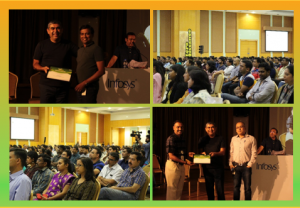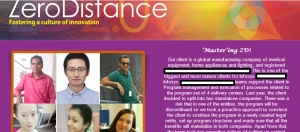In this first edition of Intraskope’s Spotlight on Internal Communication Series, Shruthi Bopaiah – Associate Vice President and Head – Internal Communications at Infosys, one of India’s leading technology services and consulting firms, shares her experiences of disseminating the CEO’s mandate of a culture of innovation through Zero Distance (ZD), a ground-up innovation initiative. She explains how internal communication enhanced employee appreciation of innovation, improved customer experiences and changed perceptions about the function.
Issue that needed addressing
In mid-2014, Infosys hired its first non-founder CEO, Dr. Vishal Sikka, who introduced a vision to renew our core business while fostering a culture of innovation and learning. To bring this vision to life and embed it in our organization’s culture, we needed to inspire a grass-root movement and propel the organization into the future. Helping employees embrace this large-scale transformation and change in all our projects seemed vital to the success of this vision.
Innovation at Infosys was always often used in conversations although employees didn’t quite understand or appreciate what it meant. Even though projects created innovative solutions and solutions for their customers, others rarely heard of it. Teams innovating in silos prevented true collaboration and culture-building from within. With an evolving business landscape, innovation and collaboration needed to be a way of life, and projects that earlier believed that they weren’t innovative enough needed to be taken along this journey.
Measuring the value of business innovation seemed to be a challenge without a consistent approach and standard. Teams ticked the box on innovation rather than blend it into their ways of working. Making innovation tangible, real and measurable became a priority. It needed a framework for teams to identify and act upon. Likewise, leaders needed to see innovation working in their teams to foster collaboration and bring out the best in them. The time for a movement was ripe – to rally employees on a common purpose – innovating for a better Infosys and improved customer success.

With technology disrupting the world of work and success, teams needed to partner and engage each other to stay ahead of the competition. ZD served as a timely intervention give our organization the impetus for cultural immersion and innovation. To make it a reality we needed to go beyond team boundaries and leadership tiers and get embedded in the heart and minds of Infoscions.
For this, internal communication played a strategic role, to percolate the principles of ZD in the consciousness of employees across the globe, across levels and across roles. Infosys, established in 1981 is a NYSE listed company with over 1,98,000 employees and a market capitalization of approximately USD 34.50 billion.
The intervention
ZD, as a concept focused on three tenets – ZD to code, value and the end-user. It applied Design Thinking to the culture of an organization. ZD attempted to completely understand our clients’ needs, even those unrealized by the clients. By appreciating these needs, we expected to go beyond our stated work and provide additional value for clients and across service lines. And to guide our employees in their ZD quest, we introduced a 5 point framework for innovation which urged employees to look for improvements and communicate them promptly.
While the concept sounded simple, making it work needed a lot more effort. Communicating the principles to all employees in a manner that they understood and acted expected us to creative approach the challenge. After all, this was a culture building exercise we were starting from ground zero. To make this initiative a success the following enablers were crucial – communication, leadership buy-in, knowledge-sharing, ease of collaboration, recognition and rewards, success measurement and articulating our way forward. The Internal Communication team played a pivotal role in each of these aspects. With the CEO driving the agenda and investing a lot of his time in articulating the vision and engaging people, it gave us the impetus to get any many employees involved as possible too.

Throughout the process, the Internal Communications team was embedded in the Zero Distance Project Management Office: conceptualizing ideas and branding, thinking about the tenets and all the while involving employees and taking their feedback on board.
Once we defined the concept, the team swung into action, leveraging all available channels of communication at Infosys to get people to live ZD.
- Emails and videos by the CEO and leadership
- Leaders blogs
- Weekly emails for knowledge sharing
- Live Interactions with the CEO for project reviews
- Media coverage
- Videos on the internal TV platform
The Internal Communication team’s role
As part of the central PMO running the initiative from the business, we were responsible for bringing the concept of ZD alive and to connect it closely to the culture.
Culture change is not easy, so some of the challenges that we were prepared for were: the initial phase where employees were unable to grasp the concept, the skepticism that this sounded like
‘old wine in a new bottle’ , limited interest to collaborate and a “what’s in it for me” reaction. Therefore, over the next few months, we tackled each challenge head-on and deployed best practices we discovered within the business speedily to enable the spread of Zero Distance as a grass-root movement.
To ensure that the message seeped through, we leveraged existing Communication channels, found new opportunities and looked at both traditional and non-traditional methods of communication:
- The CEO directly communicating to our top managers in a video webcast
- Reinforcing and reiterating the messages
- Highlighting the best Zero Distance teams and their solutions for knowledge-sharing
- Launching our mobile-enabled enterprise collaboration platform within a few months of ZD’s launch. This platform now has over 58000 registered users and thousands of groups across topics like automation, tech, learning, hobbies, etc.
- Blogs on the intranet
- InfyRadio and InfyTV
- Launch of a ZD app which hosted a knowledge repository of project information for employees to research, learn and integrate into their own projects
- A robust rewards and recognition platform that included quarterly awards for outstanding teams and individuals, along with the teams that received the most client testimonials for their ZD work.
To us, the most impactful form of communication on this initiative turned out to be the Zero Distance Project reviews led by Vishal Sikka and other leaders. Vishal and his team invited thousands of Infoscions to witness the cool ZD work done by project teams. It helped build a sense of pride as teams presented their work and received feedback personally from the CEO. Since the launch of the first session in April 2015, we held close to 40 interactions across our offices. Despite the complex logistics of organizing these sessions we used multiple media like audio bridges, found chunks of our CEO’s time over many months, held video conferences, conducted webcasts so that no one was left behind in the company and got a chance to participate actively. These sessions became a benchmark of sorts, with other teams attempting to emulate similar initiatives.
All these forms of communication served a larger purpose – it motivated employees to implement ZD. Teams that were reviewed by Vishal and his team were proud to have been chosen for this, and others sought coveted spots. They worked harder to be featured in the weekly emails and on the intranet. More projects began to implement ZD ideas and built proof-of-concepts to showcase for our clients. Delivery managers began to review their teams’ solutions rigorously before they were uploaded into the project management system.
The impact
In the span of a few months, ZD moved from just a buzzword to a recognizable movement across the company. Employees were talking about it, and so was the media. Business leaders were ensuring that their projects were showcasing cool, innovative work, and we began seeing results in client conversations and in monetization.
In the second year, the focus increased on monetization of ZD ideas, and revenue began to flow for the company. Clients were willing to give testimonials of the amazing work done as well.
Campaign metrics:
- 15,000+ ZD plans across the company
- 90%+ coverage of employees who are working on ZD projects
- Over 800 client testimonials
- Clear monetization from ZD Plans
- ZD came up as one of the most talked about topics in our annual employee engagement survey
- Numerous media articles, including articles by Forbes and Economic Times and Times of India.
- We received the highest external client satisfaction scores (client delight scores) in the last 10 years
- Increased leadership connect through the interactions with the CEO, and periodic emails
- Thousands of conversations on the enterprise social networking platform
The intangible benefits included an increase in the creative confidence of employees, who were now willing to speak openly to their clients about the work that they do, and could do for them. Employees were more willing to contribute to the revenue from their projects, by delivering additional value. The most important benefit was that ZD became a part of the organization’s culture, and our delivery DNA. It was also called one of the biggest employee engagement initiatives by the CEO.
How it changed stakeholders’ perception of the team
The Internal Communication team is usually perceived as a nice-to-have business enabler function, without any role to play in delivering actual revenue for the company. At Infosys, our execution of the Zero Distance initiative, and our role in the strategic team that conceptualized and carried out the program changed this misconception. Stakeholders, especially the business/delivery unit teams realized that our role went beyond creating collateral. Also, we were now as responsible as anyone else towards monetization, meeting revenue targets, and delivering quality work.
With this, our stakeholders knew that we understood the business of our work and that our voice, representing employees we sought feedback from, was important to be considered at the start of any change management program. While the new business strategy is still in its nascent form, we are consulted for our thoughts early in the process.
Your personal learning
Through the ZD campaign, we took the effort to understand our business, to contribute more than was expected. This helped my team and I a lot in understanding how much more we could do, and we learnt a lot as well. The take away – all Internal Communications teams must go beyond their comfort zones and learn to learn, all the time, in all spaces and fields.
The demarcation between business and enabling functions is often fuzzy and so we shouldn’t shy away from the core business just because we think we don’t know enough. To a large extent, we have seen that every individual views communication, especially new campaigns and business actions independently. Therefore, “not knowing enough” applies to all of us in some way.
That is why, given our regular connect with employees as internal communicators, we can provide a holistic view of any change, taking place in any part of the organization. This Big Picture is sometimes missed by the leadership too.
Actions that could have been done differently
Given that the largest group of our employee workforce sits in our India locations and are anyway in touch with everything happening within the company, we could have increased our focus on employees at client sites a bit more at the start. While they eventually got excited about this concept a few months in, we could have tapped into their potential by involving them earlier.
The campaign was also very delivery-focused, to the extent of making some enabling functions feel like their role in ZD seemed smaller than the rest. This could have been different as well.
As a reader, what did you personally learn from this case study? Please share it here!
If you have any suggestions about similar content on internal communication that will be relevant for you please do drop me a note at [email protected]

